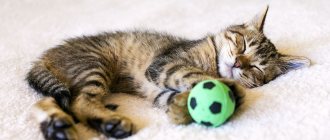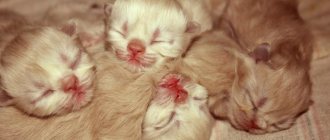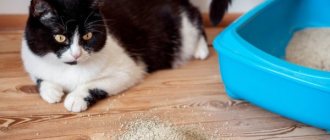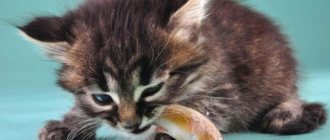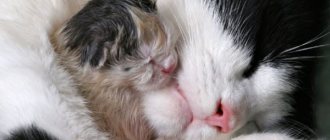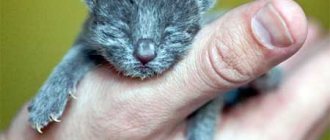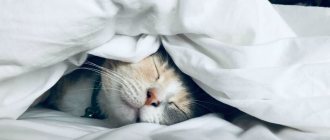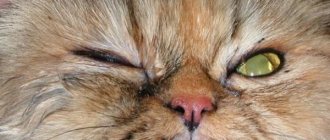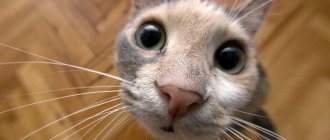Main reasons for color change
Eye color depends on the amount of pigment in the cells of the cornea, the formation of which begins in the embryonic period.
The cat's gestation period ranges from 55 to 63 days. In this short period of time, inside the mother, two united cells must develop into a relatively large, smoothly working organism.
The mother's resources are limited, so the melanin she synthesizes is primarily sent to the skin and fur cells of the fetus. This allows you to quickly form reliable covers for effective thermoregulation and protect the kitten from an aggressive external environment. In this case, the cells of the iris are deficient in melanin, which is why they remain colorless during birth and several weeks later. As the kitten grows, its eyes gradually open, vision becomes clearer, and the eyes acquire a color dictated by breed and heredity.
View this post on Instagram
This is how our Gipsik grew up)) we are very glad that he ended up with wonderful people)) He had a very difficult fate, but that’s all in the past! Now he is an affectionate, sociable and very playful adult cat) #favorite gypsik #difficult name #zoovetsnabreutov #changing eye color
A post shared by Olesya Mangalis , Skrylnikova (@olesyaskrylnikova) on Feb 18, 2020 at 1:42pm PST
Anatomically, the cat's cornea consists of two layers: stroma (upper) and epithelium (lower).
The degree of saturation of the stroma with melanin determines the shade of the kitten’s eyes. If there is little of this substance in the cells of the iris, the eyes will be blue or blue. If a little more - green. With a high melanin content, the eyes turn coppery brown.
Can street kittens be like the British?
In childhood, all babies are similar to each other. Of course, if you place a mongrel cat next to a Briton, the difference between them will be visible to the eye. But it is almost impossible to distinguish a litter, especially if the kittens come from short-haired parents, without the help of a specialist for the following reasons:
- All newborn kittens are fluffy. Later they will be divided into short- and long-haired, but at first they all have the same coat.
- Characteristic breed features, for example, round cheeks, are almost invisible at an early age.
- There is always a risk of giving birth to mestizo (a cross between British and outbred cats) - in this case, the chances are halved.
Can eye color not change?
The embryo inside the uterus is not exposed to ultraviolet radiation, so during pregnancy it receives an extremely small amount of melanin from the mother. This explains the fact that every kitten is born with closed eyelids, which open only in the third week of life.
The main function of melanin is to protect the body from exposure to ultraviolet rays.
The eyelids protect the delicate pupils, devoid of pigment, from the sun's rays. As the iris matures, the eyes open, but for a long time retain a dull gray-blue tint due to the translucent film.
The idea that there are certain breeds or individual cats that are born with a constant eye color is erroneous.
The fact is that the stages of formation of a cat’s body are standard for all breeds and depend on the characteristics of the blood lines. Even a blue-eyed cat will have a very different iris at birth and as an adult: as it grows, the cloudy bluish-gray will change to a bright icy-clear or deep blue color.
Dichromatic eyes
In this case, the pet has two shades of the iris on one eye. Sometimes it looks like a colored ring around the pupil of a different shade, or the eye is divided into two different colored fragments.
Important! Judges at professional cat shows consider this a disadvantage, but amateurs consider it a cute and attractive feature. Sometimes mirror dichromacy occurs in both eyes at once.
When do major changes occur?
The first changes in the shade of the cornea can be seen already in the fourth week of a kitten’s life. Melanin begins to concentrate in the pigment centers of the iris, and gradually small patches of a different color appear on the bluish field.
By 4 months, you can get an impression of the approximate color of the pupils. The final shade will be established only upon reaching the age of two, when the formation of the body is completed and the kitten enters the maturity phase.
Since the shade of the iris is a determining factor for the breed, it is recommended to choose a kitten at the age of 4-6 months. At this time, even an inexperienced breeder will be able to correctly determine whether the future pet meets the breed standards.
How not to buy a fake British
A purebred cat cannot be cheap. If someone offers a “real” British cat for ridiculous money, then the kitten is not British after all. Only conscientious breeders and reputable nurseries give a guarantee of the “quality” of the breed.
They value their reputation very much, kittens are sold only after reaching the age of 3 months, and at the same time they are very interested in what hands their pets fall into.
Those wishing to purchase a purebred British cat select options in advance, consider alternative scenarios, and even first meet the parents of the future kitten.
It has been noticed that the English breed is most favored by wealthy and independent people who spend a lot of time outside the home and are accustomed to having all the best around them. In such a situation, a British kitten would be an ideal option.
He is beautiful, independent, and will never get bored or offended by his owner for long hours of loneliness. A complete coincidence of characters and desires is the best guarantee of peaceful and happy leisure time together.
Standard colors
The standard eye shades for cats are:
- Green. Allowed in cats with a predominance of black, blue, lilac color, coat of cinnamon, fawn, chinchilla color.
- Yellow. Characteristic of tabby cats.
- Copper. Allowed for cats with black, chocolate, lilac, blue, red, cream color.
- Icy and light blue. Acceptable for all white cats.
However, white cats with blue eyes are often deaf in both ears. Among white pets with one blue eye (heterochromia), unilateral deafness (on the side of the blue eye) is observed.
Green-eyed breeds
Long-haired and short-haired Persians with a chinchilla-colored coat are known for their green eyes with a black “rim.” The Tonkinese breed has striking sea green eyes.
Russian Blue cats have emerald green eyes that contrast beautifully with their gray-blue coat. And the Egyptian Mau's irises resemble juicy gooseberries.
Breed differences
The standard for each breed contains a list of acceptable iris shades.
All Thai cats must have blue eyes. The aquamarine hue of their pupils should be bright and deep. Dullness is considered a disqualifying factor, excluding the animal from breeding work. Similar requirements apply to representatives of the Siamese breed.
Burmese beauties should have eyes ranging from a rich golden to lemon shade. Any deviation from the standard is unacceptable. Oriental cats are distinguished by grass-green eyes of varying intensity. For British and Scottish cats, copper, amber or terracotta colored eyes are preferred. And a green iris will ruin the exhibition career of even the most beautiful British woman.
Maine Coons can have corneas of any shade. The main thing is that the color is as pure as possible and does not contain other inclusions. The same requirement is prescribed for representatives of the Bengal breed. The only exceptions are individuals with the lynx point (snow) color, which must be blue-eyed.
Siberian cats are the pride of Russian felinology. Green and yellow shades of the pupils are considered the most acceptable for them. However, the color-point Siberian subspecies Nevskaya Maskaradnaya should have a piercing sky-blue gaze.
How to distinguish a British kitten from an ordinary one
The differences between British kittens are obvious to those who are familiar with the standard of this breed.
Body types in cats
The small British kitten looks like a ball, its body is dense, with rounded shapes.
- thick paws;
- squat body, with a massive chest and straight back;
- the tail is wide at the base, with a rounded tip;
- small neat ears set very wide;
- Even very small British kittens have a powerful and short neck.
Similar external characteristics are absent in outbred kittens, although all of the listed external characteristics may be present in a crossbreed.
A small clue can be found in the baby's weight. Newborn kittens usually show approximately the same figure - from 80 to 140 g. But at the age of 3 months, the difference between British and outbred kittens will already be 0.5 kg, and after another month it will reach 1 kg.
Comparisons by weight are rarely useful under normal conditions. Even scammers do not risk showing kittens of two breeds at the same time - the difference between them after the first two months of life is already obvious.
Important! It is necessary to take into account such a feature as sexual dimorphism - the difference in the anatomy of boys and girls. Males are always larger and heavier than females.
Coat and color
At the age of 60 to 100 days, pay attention to the color and quality of the kitten’s coat. You can try to distinguish a British Shorthair from a regular kitten by color.
The breed standard allows about 250 different combinations, including very rare ones:
- lilac;
- chocolate;
- cinnamon;
- faun.
Outbred cats do not have such coat colors. Even the traditional British gray-blue color is practically not found in street cats. If we are talking about bicolors, solid white, red, black, tortoiseshells or patterned tabbies, there will be no difference between them.
Another distinguishing feature is the quality of the wool. In the breed standard it is characterized by the term “crispy” - dense, with a fine plush texture and thick pile. But in 2-3 month old kittens this sign is not yet expressed, and even color cannot be considered as the main one.
By the age of puberty, the Briton's coat begins to color, and only then takes on its final color.
Eye color and shape
The next feature that distinguishes a British kitten from an ordinary one is the eyes.
- shape – round, size – large;
- set wide relative to the bridge of the nose;
- the pupil is bright, without inclusions of foreign color.
Important! For the British cat breed, a bright honey or amber shade is considered traditional, but it all depends on the color of the coat. The Siamese color-point is always combined with blue eyes, and the chinchilla amazes with the range of lavender and green pupils.
Height and weight of British cats
Representatives of the British breed have a rather large build by nature and, accordingly, the British also weigh quite a bit. In addition, the weight of an adult cat depends on its lifestyle and diet.
The normal weight of a newborn British kitten, regardless of whether it is blue or chocolate, should be between 60 and 140 grams. Moreover, its size ranges from 9-14 cm. How to name a British kitten >>How to name a kitten based on the length of its fur >>
Considering that the British grow up to the age of 5, we suggest finding out in more detail what size the animal grows to each year.
The table shows the weight of British people depending on gender.
| British age | British cat weight | British cat weight |
| 1 year | 2-4 kg | 4-6 kg |
| 2 years | 2.5-4.5 kg | 4.5-6.8 kg |
| 3 years | 2.8-4.8 kg | 4.7-7 kg |
| 4 years | 3.8-5 kg | 4.9-7.5 kg |
| 5 years | 4-6 kg | 5-8 kg |
So, the average weight of a mature British adult can be from 4 to 8 kg. Today, the largest representative of the breed, named Chest, weighs 12 kg! Moreover, this is not the maximum weight of a pet. Since he is only 4 years old, the cat will probably grow up.
The British cat is truly a bright representative of the oldest purebred pets. Its extraordinary resemblance to a children's plush toy can inspire anyone to believe in the best and calm them down after hard everyday life.
More articles on this topic: All about the British breed
Types of British
Health of British cats
History of the British breed
Age-related changes
Another inevitable reason why a cat's fur color has changed is age. And not only very old age, but also 5 years and even 3 years. The color usually darkens with age.
The multi-colored patterned colors gradually blur and turn into mush. The matter is complicated by ticking - coloring each hair with several transverse rings of light and dark tones. It should be noted that the patterned color cannot appear without ticking: these characteristics are genetically related.
Origin of color
The first British cat of Blue color appeared in 1871 and took first place at a cat show. The cat was introduced by breeder Harrison Ware. The appearance of the Briton charmed fans, but only in 1950 did she gain recognition in American felinology.
For over a hundred years, breeders have worked to achieve the perfect standard of the British Blue. To achieve the result, they were mated with various breeds of cats: Persian, French, and blue Russian cat. It has been established that the recessive Blue tone is a diluted black pigment. Therefore, the color varies over a wide spectrum from dark graphite to light gray, rich blue. Now certain standards have been established for the color of the breed; according to color, it is rated up to 25 points.
Breeders have difficulties with breeding; according to the rules of genetics, this is a recessive color and two Blue parents can produce the same kittens of both sexes. When mating with other colors, it is difficult to get blue kittens.
Eyes
Not only the beautiful, soft, shiny coat evokes admiration, but also the charming, large, round eyes. They are widely spaced relative to the nose, which gives them more expressiveness. The coat color of a British cat looks good in the photo in combination with their eyes, which are copper, orange, and golden.
Due to the yellow color of the eyes and the gray-blue color of the coat, the pure British cat is sometimes confused with a mixed breed from a Russian cat, but they are distinguished by the shape of the head and the full cheeks characteristic of the blue solid.
How coat color changes with age
In kittens, the outer hair looks like soft fluff, and the shade is not yet saturated, like in adults. The true color appears after puberty. Then junior molting occurs, especially pronounced in males.
The structure of the coat changes, it becomes denser and rougher to the touch. The pattern becomes blurry, and some kittens' spots disappear.
Important: In summer, the wool fades in the sun, and in winter it darkens. Also, after 3 years, the color becomes brighter and more saturated. Food affects the shade; in white kittens, the fur darkens due to carrots and beets.
Emeralds - for gold and silver
What are the eyes of British cats that have “noble metals” in their colors? If we are talking about gold, that is, the colors “golden tabby”, “golden shaded” or “golden chinchilla”, then only a British cat with green eyes corresponds to it. There are no other options - gold in this case should only be combined with greenery in bright shades.
As for silver cats - the same tabbies, chinchillas or “silver tabbies” - their eyes can be either green, preferably a shade of turquoise, or yellow-orange.
Features of British hair care
There are also some differences regarding the hygiene and living conditions of black British cats.
- British fur coat color can vary depending on diet. For example, food containing beets is suitable for dark-colored cats. But a large amount of seafood on a cat’s menu can negatively affect the color of the paws and nose - these areas of the body will become lighter, in contrast to the main shade.
- When exposed to ultraviolet light, a black cat's fur becomes dull and takes on a gray tint. To restore color, you will have to limit the time your pet stays in direct sunlight.
Despite the short hair, the British cat needs regular brushing during shedding. The procedure is carried out several times a day using a special mitten or comb.
Contents of a Black Briton
Contrary to popular belief that the British are difficult to look after, the reality is completely different. If you follow simple rules of care, a four-legged animal can easily live up to 18, and sometimes 20 years.
There are just a few nuances that you should pay attention to.
Namely:
- Avoid hypothermia of animals and do not place their houses in drafts. Representatives of these breeds have weak eyes. Therefore, at the slightest breath of wind, their eyes begin to water and sour.
- Visit a veterinarian regularly, especially for owners of animals over 10 years old, and get vaccinated.
- Feed your cats correctly.
- Do not allow frequent matings (for cats), this weakens the immunity of fluffies, they begin to get sick often.
Caring for cats involves proper feeding. This can be high-quality dry food or canned food, as well as natural food.
First you need to decide, and then carefully select your diet. If preference is given to dry food, then it is better to choose the holistic or super-premium lines. Many brands offer food specifically for the British, taking into account their age.
At the same time, veterinarians advise choosing food based on the four-legged lifestyle. If the animal is overweight, then it is worth purchasing appropriate food. If the cat does not leave the house, therefore, it is necessary to purchase appropriate food. It's all written on the packs. In addition, veterinarians working in specialized pet stores will always give advice and help, so this will not be a problem.
Some owners worry that their British black kitten will go hungry while they are at work. Therefore, they leave the drying directly in the bowl, pouring it with a mountain. This cannot be done because, firstly, the feline’s stomach will quickly stretch out, and secondly, they will get used to the fact that they can eat as much as they want, and then they will not leave their feeder. Considering that the British are prone to obesity, doing this is strictly prohibited.
Animals must be given eggs at least a couple of times a week. The same applies to dairy products. True, there should not be an excess of them. To maintain the charcoal shade of the coat, you can add kelp to your food from time to time. If the cat is repelled by the smell, then it is worth buying vitamin complexes that contain these algae and giving them.
You should forget about food from the table. British black cats, like representatives of other colors, begin to get sick if they consume fat, salt and spices in excess. All this is present in the food that a person eats. All this is prohibited for animals.
Grooming
Many people believe that the British Shorthair black cat's coat does not need to be looked after. However, it is not. If the animal is not combed at least once a week, the hairs will begin to tangle and cough. Therefore, this procedure cannot be avoided. To do this, it is better to buy a soft brush that will not injure the skin.
Cats should not be bathed frequently. If the animal walks along the street, then “bath days” must be organized 2 times a year. For bathing, you should take shampoos designed specifically for black Britons. These cosmetics are sold in pet stores.
